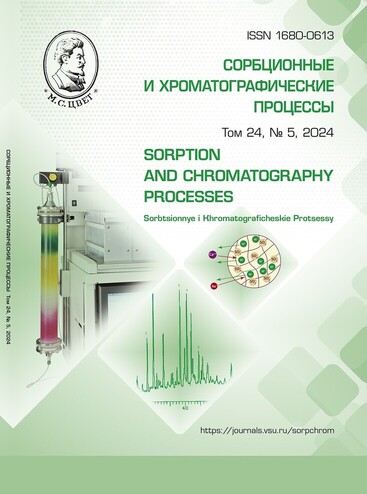Theoretical model of voltammetry of selective dissolution of an alloy with accounting the effects of equilibrium solid-phase adsorption and surface roughness
Abstract
The problem of unsteady-state diffusion was numerically solved for potentiodynamic polarisation during the anodic selective dissolution of a binary homogeneous alloy. We considered the fractal and statistically irregular roughness of the electrode surface and the equilibrium solid-phase adsorption of the alloy’s system components. The concentration profiles of the electrochemically active component of the alloy, anodic polarisation curves, and roughness function were calculated. We determined that the effect of surface segregation does not affect the shape of the anodic voltammetry, does not change the criterion of diffusion kinetics, and is mathematically reduced to a change in the current strength proportional to the function of solid-phase adsorption. We revealed the role of fractal and statistically irregular roughness of the electrode in the criterion dependence of the maximum current strength on the potential scan rate. The voltammetry response depends linearly on the surface roughness factor at relatively high or very low potential scan rates. This dependence is caused by a significant change of the diffusion front from repeating the surface profile to a nearly flat shape. In these cases, the parabolic criterion of diffusion kinetics of voltammetry is not changed. The time dependences of the roughness function for surfaces with different roughness factors and fractal dimensions were obtained. We determined that an increase in these morphological parameters, as well as a decrease in the potential scan rate, increases the probability of the Randles-Sevcik dependence curvature. The obtained data can be used to develop a method of controlling the composition of alloy coatings, including those obtained by chemical or electrochemical deposition, as well as to estimate the roughness factors and fractal dimensions of their surface using unsteady-state electrochemical measurements.
Downloads
References
Aljibori H.S., Alamiery A., Kadhum A.A.H. Advances in corrosion protection coat-ings: a comprehensive review. Int. J. Corros. Scale Inhib. 2023; 12(4): 1476-1520. https://doi.org/10.17675/2305-6894-2023-12-4-6
Biryukov A.I., Kozaderov O.A., Batma-nova T.V. Features of the corrosion of coatings based on zinc alloys: oxidation products and the selective dissolution of zinc. Review. Kon-densirovannye Sredy I Mezhfaznye Granitsy = Condensed Matter and Interphases. 2024; 26(1): 25-36. https://doi.org/10.17308/kcmf.2024.26/11806
Kozaderov O.A., Yudenkova L.V., Sot-skaya N.V. Corrosion resistance and catalytic activity of nickel coatings electrodeposited from a chloride-glycinate electrolyte with the addition of thiourea. Int. J. Corros. Scale In-hib. 2024; 13(2): 1029-1042. https://doi.org/10.17675/2305-6894-2024-13-2-21.
Zangari Giovanni. Electrodeposition of Alloys and Compounds in the Era of Microe-lectronics and Energy Conversion Technology. Coatings. 2015; 5(2): 195-218. https://doi.org/10.3390/coatings5020195.
Bahramian A., Eyraud M., Vacandio F., Knauth P. Cu/Ni/Au multilayers by electro-chemistry: A crucial system in electronics - A critical review. Microelectronic Engineering. 2019; 206: 25-44. https://doi.org/10.1016/j.mee.2018.12.008
Dini J.W. Electrodeposition. The Materi-als Science of Coatings and Substrates. New Jersey (USA): Noyes Publications, 1993. 384 p.
Galus Z. Fundamentals of Electrochemi-cal Analysis. Ellis Horwood: New York, 1976. 520 p.
Bard A.J., Faulkner L.R. Electrochemical methods. Fundamentals and applications. N.-Y. (USA): Wiley, 2000. 856 p.
Trasatti S., Petrii O.A. Real surface area measurements in electrochemistry. J. Electro-anal. Chem. 1992; 327(1-2): 353-376.
Encyclopedia of electrochemistry. Vol. 4. Corrosion and oxide films / Ed. A. J. Bard, M. Stratmann, G. S. Frankel. Weinheim (Ger-many) : Wiley-VCH, 2003. 755 p.
Landolt D. Corrosion and surface chem-istry of metals. Lausanne (Switzerland) : EPFL Press, 2007. 632 p.
Marshakov I.K. Anodnoe rastvorenie i selektivnaya korroziya splavov. Zashchita me-tallov. 2002; 38(2): 139-145. (In Russ.)
Budnikov G.K., Maistrenko V.N., Vya-selev M.R. Osnovy sovremennogo elektrokhi-micheskogo analiza. M.: Mir, 2003. 592 s. (In Russ.)
Levie R. Fractals and rough electrodes. J. Electroanal. Chem. 1990; 281(1-2): 1-21.
Inoue F., Shimizu T., Miyake H., Arima R., Shingubara S. All-wet Cu-filled TSV pro-cess using electroless Co-alloy barrier and Cu seed. IEEE 62nd Electronic Components and Technology Conference, San Diego, CA, USA. 2012; 810-815. https://doi.org/10.1109/ECTC.2012.6248926
Inoue F. Study of low resistance TSV using electroless plated copper and tungsten-alloy barrier. IEEE International Interconnect Technology Conference. Sapporo, Japan. 2009: 167-168. https://doi.org/10.1109/IITC.2009.5090376
Wu W., Tang X., Wang J., Chenghan Z. Fabrication of Cu-Ni alloy microcomponents using localized electrochemical deposition. J. Electrochem. Soc. 2024; 171(5): 053507 https://doi.org/10.1149/1945-7111/ad4a07
Bobrinskaya E.V., Vvedenskii A.V., Marshakov I.K. Solid-phase surface adsorption of components in the system Ag-Au|F-(H2O). Russ. J. Electrochem. 1999; 35(10): 1054-1060.
Vvedenskiy A.V., Kozaderov O.A., Selemenev V.F. Solid-phase adsorption effect in the diffusion kinetics of selective dissolution of alloys. Sorbtsionnye I Khromatograficheskie Protsessy. 2018; 17(1): 161-167. https://doi.org/10.17308/sorpchrom.2017.17/366
Kozaderov O.A., Vvedenskii A.V. Massoperenos i fazoobrazovanie pri anodnom selektivnom rastvorenii gomogennykh splavov. Voronezh: Nauchnaya kniga, 2014. 288 s. (In Russ.)
Vvedenskii A.V., Kozaderov O.A. Lin-ear voltammetry of anodic selective dissolution of homogeneous metallic alloys; Voltammetry: Theory, Types and Applications / Editors: Yuki Saito and Takumi Kikuchi. New York: Nova Science Publishers, Inc. (USA), 2013: 269-292.
Kutateladze S.S. Osnovy funktsion-al'nogo analiza. Novosibirsk: izd-vo In-ta ma-tematiki, 2000. 336 p. (In Russ.)
Potapov A.A. Fraktaly v radiofizike i radiolokatsii: topologiya vyborki. M., Universi-tetskaya kniga, 2005. 848 p. (In Russ.)
Kozaderov O.A. Effekt sherokhovatosti poverkhnosti v kinetike geterogennykh protsessov. Obzor. Kondensirovannye sredy i mezhfaznye granitsy. 2017; 19(1): 6-21. (In Russ.)
Berry M.V., Lewis Z.V. On the Weier-strass-Mandelbrot fractal function. Proc. R. Soc. Lond. A. 1980; 370(1743): 459-484.
Lin N., Lee H.P., Lim S.P., Lee K.S. Wave scattering from fractal surfaces. J. Mod-ern Optics. 1995; 42(1); 225-241.
Schaefer D.W., Martin J.E., Wiltzius P., Cannell D.S. Fractal geometry of colloidal ag-gregates. Phys. Rev. Lett. 1984; 18(26): 2371-2374.
Pfeifer P. Fractal dimension as working tool for surface-roughness problems. Appl. Surf. Sci. 1984;18(1-2): 146-164.
Gallager R. Metod konechnykh elemen-tov: osnovy. M.: Mir, 1984. 428 s. (In Russ.)
Trukhan S.N., Derevshchikov V.S. Komp'yuternoe modelirovanie protsessov i yavlenii fizicheskoi khimii. Novosibirsk: NNI-GU, 2012. 75 p. (In Russ.)
Egorov V.I. Primenenie EVM dlya res-heniya zadach. SPb: SPb GU ITMO, 2006. 77 p. (In Russ.)
Voznesenskii A.S. Komp'yuternye metody v nauchnykh issledovaniyakh. M.: MGGU, 2010. [Ch. 2]. 107 p. (In Russ.)
Krasnikov G.E., Nagornov O.V., Starostin N.V. Modelirovanie fizicheskikh protsessov s ispol'zovaniem paketa Comsol Multiphysics. M.: NIYaU MIFI, 2012. 184 p. (In Russ.)
Kozaderov O.A., Sazhneva O.V., Koroleva O.V., Vvedenskii A.V. Tverdofazna-ya diffuziya pri potentsiostaticheskom rastvorenii serebra, legirovannogo zolotom. Zashchita metallov. 2005; 41(4): 360-371. (In Russ.)
Kozaderov O.A., Bobrinskaya E.V., Kartashova T.V., Vvedenskii A.V. Tver-dofaznaya diffuziya pri gal'vanostaticheskom anodnom rastvorenii Zn,Ag- i Su,Au-splavov. Zashchita metallov. 2005; 41(5): 485-495. (In Russ.)
Bobrinskaya E.V., Vvedenskii A.V. Solid-phase surface adsorption in Ag-Au |F-, H2O and Ag-Au|ClO4-, H2O systems: allowing for the solid-solution. Russ. J. Electrochem. 2001; 37(9): 947-951







